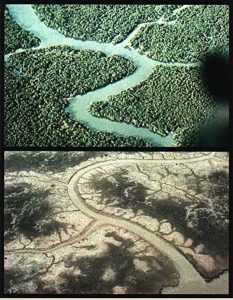
The intent of using Agent Orange was to accomplish two goals: first, to destroy the brush that could be hiding enemy forces and, second, to drive the people in rural villages into the city where they were less likely to eventually join the Viet Cong (Palmer 2007).
Agent Orange was an incredibly effective herbicide in the sense that it absolutely ravaged the flora of Vietnam over the decade that it was sprayed. In specific, the dioxins completely devastated mangrove growth, which has largely not recovered and is in many often considered irreversible (Palmer 2007). One of the most important components of the dioxin in Agent Orange is the fact that it bioaccumulates (Palmer 2007). Essentially what this means is that the concentration of dioxin will increase up the food chain. If the dioxin is sprayed and gets into a water source that contains fish, the dioxin will build up in the fish, and eventually when a human eats the fish a higher concentration of the poison will concentrate within their system, and this process becomes more intense when the complexity of the food chain is considered. The concentration of the toxin additionally does not leave the persons system (Palmer 2007). Because the toxins continue to build within people’s bodies with more and more exposure, there are immense generational effects from the toxicant. Parents can pass exposure to their children during conception, while developing in the womb, and while breastfeeding (Timeline). This is a harrowing fact when the devastating toxicity of this chemical is considered. As of 1999, one million people in Vietnam reported having diseases or illnesses related to dioxin poisoning, and of these, 50,000 were children (Palmer 2007). This is significant because at this point people who are facing the effects of the poison were not even alive while it was being sprayed. Scientists and reports do not yet know how many generations could see the effects of the dioxin, but scientists expect that the implications of this deadly war could continue for generations more (Timeline).
Agent Orange has been traced to causing upwards of sixteen separate diseases. These diseases include Type II Diabetes, Hodgkin’s disease, and at least three types of cancers (Timeline). These effects, however, are not simply seen in those people directly exposed to the toxins. At this point Vietnam is experiencing at least third generational effects from the toxins, meaning that children born decades after the spraying of Agent Orange stopped are experiencing diseases and birth defects as a result. The chemicals in agent orange have the ability to mutate genes and alter gene expression, which leads to the enormous impact on babies born to exposed parents (Timeline).
The process of these damaging effects on kids is traced back to the sever effects of Agent Orange on the reproductive system. The chemicals are known to impact hormones and other developmental processes in addition to altering cell formation (Palmer 2007). Truong Van Hue is a veteran from Vietnam, who was exposed to the toxicant (Timeline). Truong Van Hue has two children who have series health problems from exposure to Agent Orange (Timeline). His two children were born in 1998 and 2002 respectively, which is roughly twenty-six years after the U.S. stopped spraying Agent Orange (Timeline). Neither of his children are capable of taking care of themselves do to both developmental and physical days (Timeline).
The chemicals used in Vietnam and the larger war additionally have implications for U.S. veterans. In terms of chemical exposure, veterans who were a part of Operation Ranch Hand are at a 50% higher risk for skin cancers (DeStefano 1995). Research also showed that veterans who had served in Vietnam were more likely to experience anxiety, depression and addiction (DeStefano 1995). 15% of United States veterans who served in the Vietnam war in some compacity had also been clinically diagnosed with Post-Traumatic Stress disorder by 1995 (DeStefano 1995). 
These impacts however do not parallel the devastation in Vietnam. Specifically, in the most rural communities, populated largely by racial minorities, the levels of contamination remain significant (Timeline). Areas known as “hotspots” are locations where toxins were repeatedly sprayed during the war and contain specifically high concentrations of chemicals (Palmer 2007). Some of these areas have been cleaned of contaminants, but the cost is enormous and many areas, therefore, remain contaminated or uninhabitable (Palmer 2007).
This map shows the areas most heavily sprayed in dark yellow. While it is not the most specific map it provides a general idea of the areas facing the most contamination (lovme).
